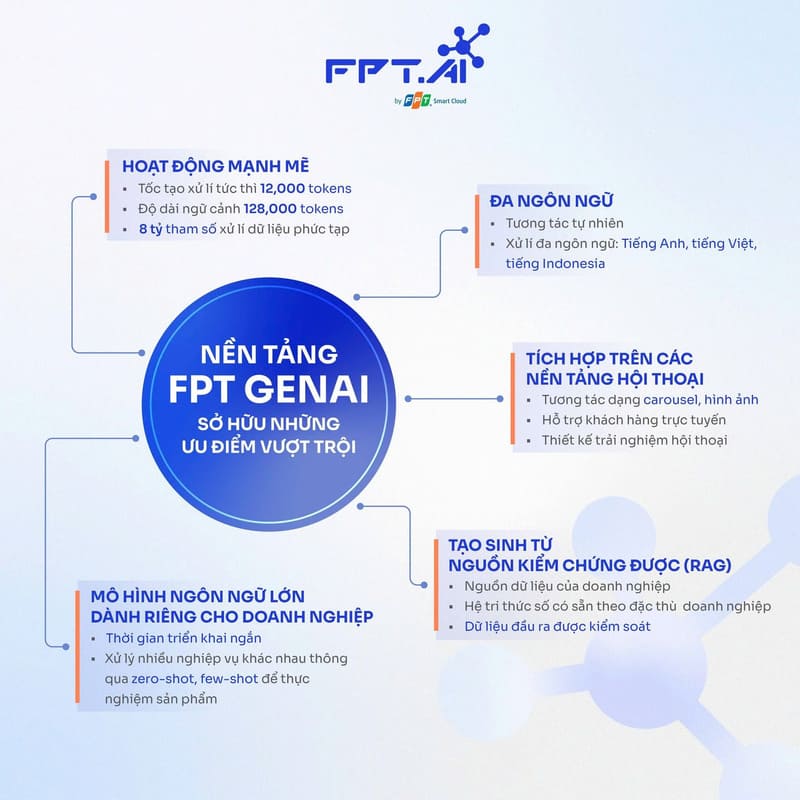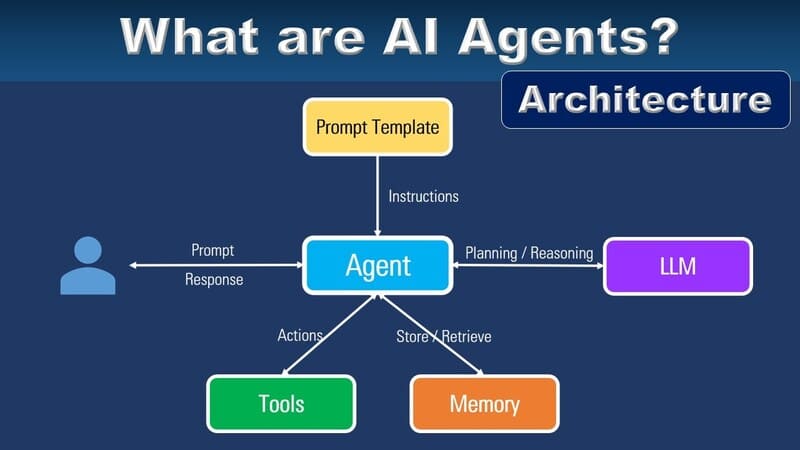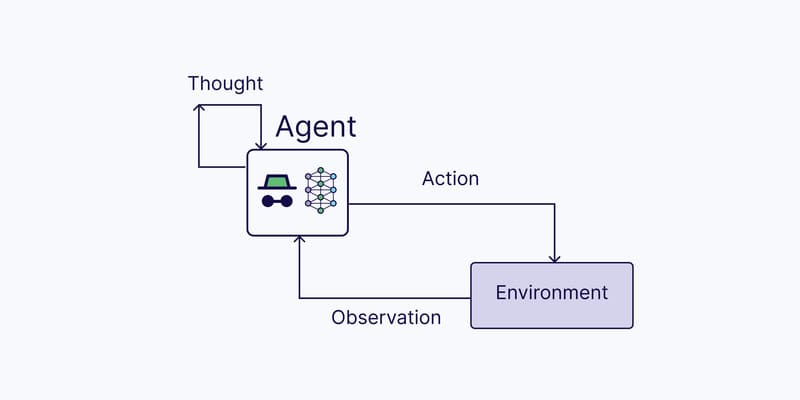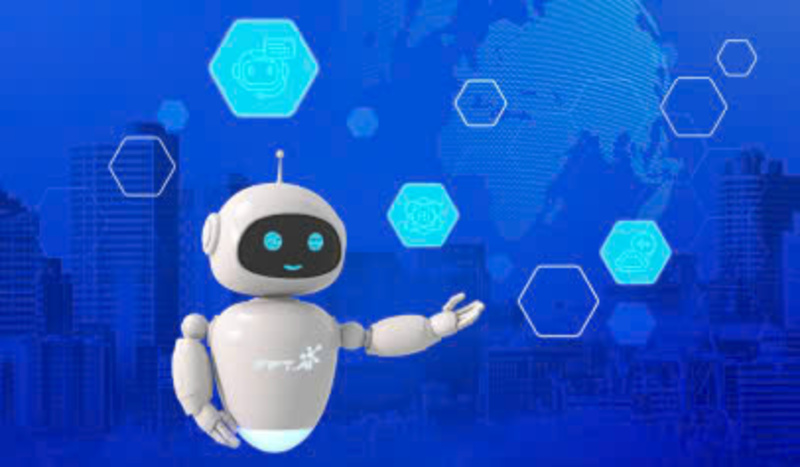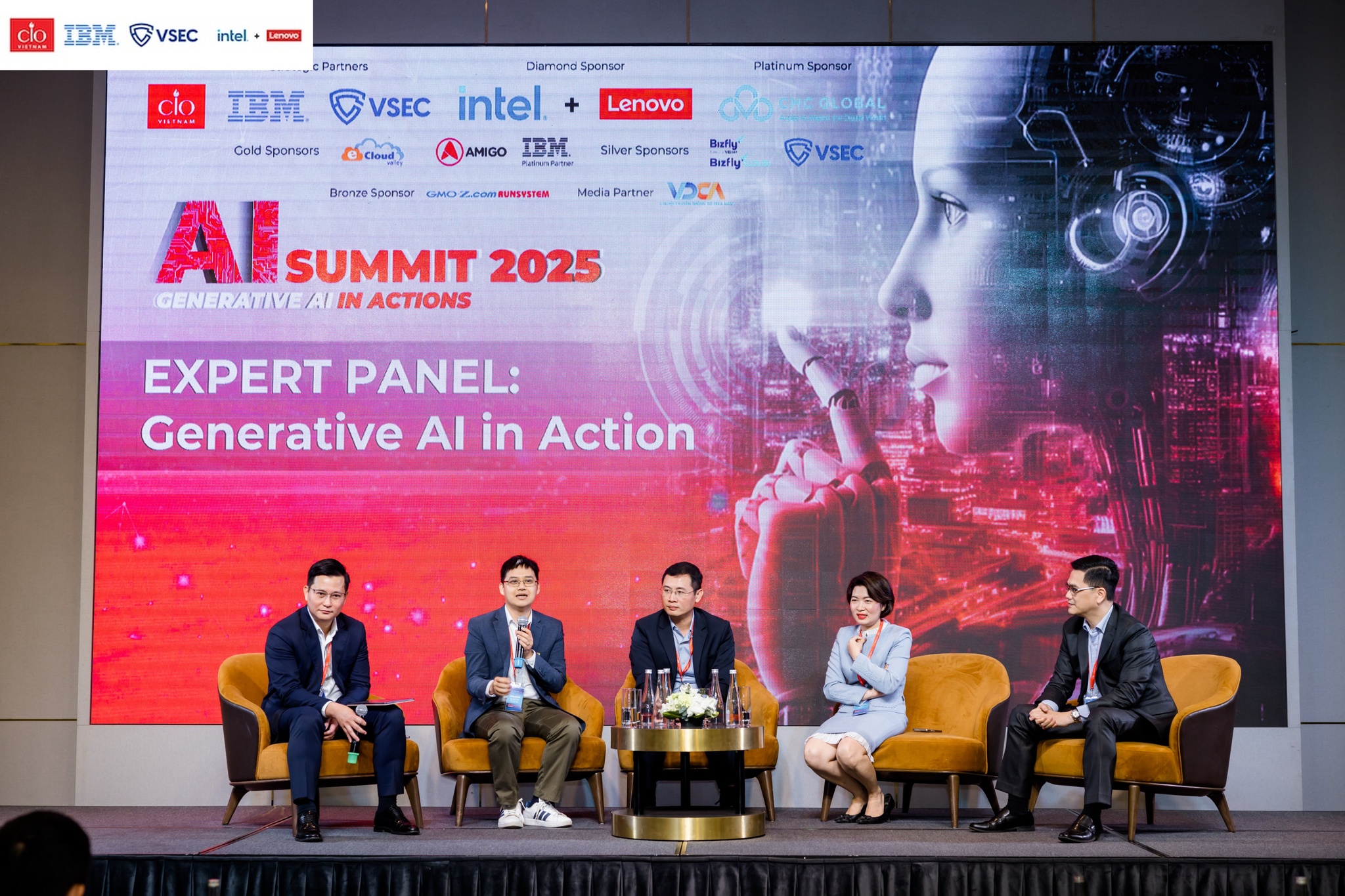In recent years, artificial intelligence has made great strides, penetrating many areas of life, from healthcare, and education to economics and entertainment. Experts say that the rapid development of AI is bringing humanity closer to the “technological singularity” – the point at which AI surpasses human intelligence, creating unpredictable changes for society.
One of the important aspects of the singularity is the emergence of Artificial Superintelligence (ASI), a form of AI that is capable of surpassing humans in all fields. So what is Artificial Superintelligence? Why do we need to research and understand ASI when this is just a hypothesis? Let’s explore with FPT.AI!
What is Artificial Superintelligence?
Artificial Superintelligence (ASI) is a form of artificial intelligence that has the ability to surpass humans in all areas, from thinking, problem-solving, and creativity to social communication. Currently, the AI we use as virtual assistants, and self-driving cars are only Weak AI or Narrow AI. To achieve ASI, we must first develop AGI (Artificial General Intelligence) – a system that can think, learn, and work flexibly like humans in all areas. The concept of Artificial Superintelligence is often associated with “technological singularity” – the point at which AI becomes smarter than humans and can completely change society. However, all of this is still just a prediction and there is no concrete evidence of the possibility of developing ASI shortly.
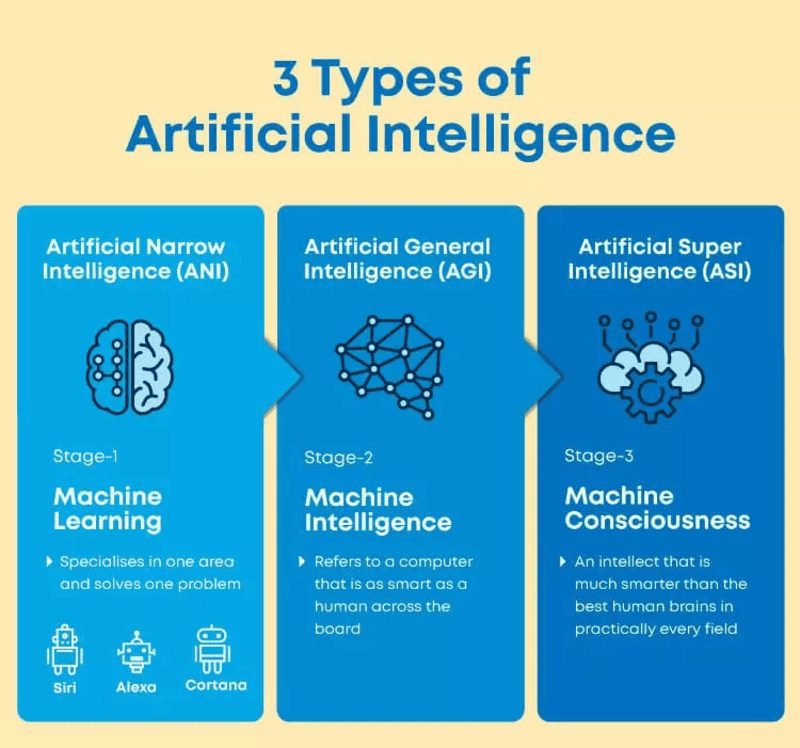
What is the difference between AI, AGI, and ASI?
ASI is often compared to AI and AGI, but there are several key differences. Read the following table for details:
| Characteristics | AI (Artificial Intelligence) | AGI (Artificial General Intelligence) | ASI (Artificial Superintelligence) |
| Description | Narrow or weak AI, designed for a specific purpose. | Strong AI capable of performing any task requiring human cognitive abilities. | Strong AI surpasses human intelligence in all domains. |
| Current Status | Exists and is widely used. | Not yet achieved; in the research and development phase. | Not yet achieved; a hypothetical concept and a future goal. |
| Capabilities | Performs specific tasks such as problem-solving, translation, speech recognition, computer vision, robotics, and navigation. | Possesses human-like cognitive abilities, including self-awareness, decision-making, problem-solving, consciousness, social skills, orientation, fine motor skills, sensory perception, creativity, and natural language understanding. | Surpasses simple brain simulation, performs any cognitive function better than humans, solves complex scientific and technical problems, and can invent and discover almost anything. |
| Requirements | Specialized hardware and software to develop machine learning algorithms. | Advances in AI research to achieve comprehensive human-like cognition. | Significant advancements in computer science, supercomputing technology, and next-generation AI. |
| Applications | Chatbots, translation services, virtual assistants, expert systems, and self-driving cars. | No real-world applications yet, as AGI has not been achieved. | No real-world applications yet, as ASI has not been achieved. |
| Risks | Limited risks, mainly related to misuse or system errors. | Potential risks if not properly controlled, could lead to unforeseen consequences. | Existential risks to humanity and potential global catastrophe if not managed correctly. |
Examples of ASI
Science fiction examples of Artificial Superintelligence include:
- R2-D2 from Star Wars, is capable of performing many technical tasks beyond human capabilities.
- HAL 9000 from Stanley Kubrick’s 2001: A Space Odyssey, is a computer program that can control the operations of an entire interstellar spacecraft.
- JARVIS from Marvel’s Iron Man, who serves as Tony Stark’s advanced AI assistant. It can understand and communicate in natural language, control the Iron Man suit, and later become the core of the Vision android’s consciousness.
Real-world examples of AI systems that could be used as the basis for future ASI systems include:
- Personal assistants are capable of natural speech recognition, such as Apple’s Siri and Amazon’s Alexa.
- Machine learning recommendation algorithms, such as the ones Netflix uses to recommend new shows and movies based on a user’s viewing and search history.
- Self-driving cars, such as those made by Tesla.
- Machine learning tools that help doctors diagnose and treat
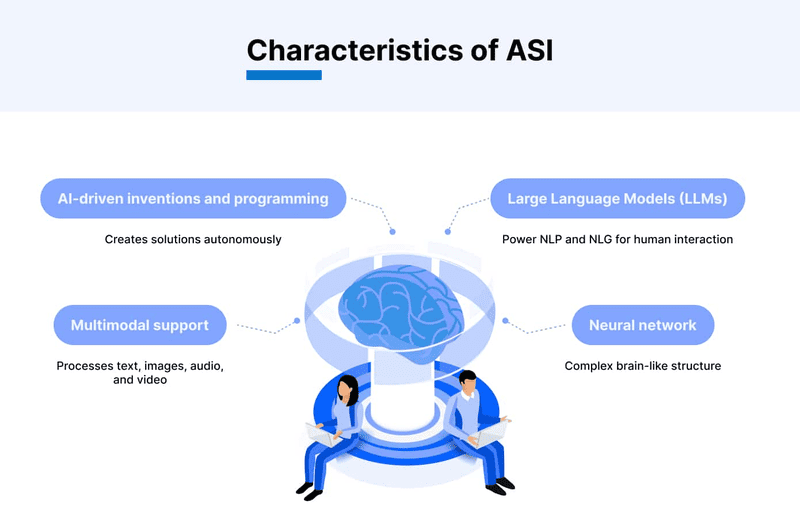
What are the conditions for achieving Artificial Superintelligence?
The creation of ASI depends on the continuous innovation of existing AI capabilities in the following technologies:
- Large language models: Models like GPT-4 (OpenAI) or BERT (Google) use natural language processing (NLP) to understand and generate human-like text content. ASI will need these models to communicate, converse, and process data naturally and flexibly.
- Multimodal AI: Artificial superintelligence processes multiple types of data (text, images, or audio) simultaneously to be able to recognize and respond like humans. For example, multimodal deep learning models are capable of not only generating images based on text but also converting speech to text.
- Neural Networks: Neural Networks are a type of deep learning software designed to simulate the way neurons in the human brain work. These networks process data in layers, helping AI learn and operate efficiently. AI researchers hope that by completely simulating the human brain, they can develop AI that reaches a level of cognition comparable to, or even surpassing, humans.
- Neuromorphic computing: Neuromorphic computing uses hardware designed based on the neural structure and synapses of the human brain. This method has higher computational power, plasticity, and fault tolerance than artificial neural networks, and can process and store data on the same neuron instead of requiring separate regions for each cell. Many researchers believe that neuromorphic computing will play an important role in future AI systems.
- Evolutionary algorithms: EA algorithms are modeled after Darwinian natural selection and evolution, which involves creating multiple AI systems and selecting the best-performing models to continue developing. These systems will improve their capabilities and performance during each selection phase, with the ultimate goal of evolving into ASI through competition.
- AI-driven programming: AI-driven programming can lead to advances in intelligent code generation, further advancing the field and capabilities of AI.
- AI-generated inventions: Like AI-driven programming, AI-generated inventions are inventions generated by AI systems. Researchers hope that increasingly advanced AI systems will propose unique, beneficial, and creative inventions, helping to improve AI capabilities.
- Integration: To achieve ASI, AI systems need to be integrated into integrated systems.
- Whole brain emulation: Also known as mind uploading, Whole brain emulation involves scanning the entire structure of the human brain and mapping the exact neural connections. The goal of the method is to create a digital replica of the brain with human capabilities.
- Brain implants and hive minds: This method involves the use of wearable technologies such as chips implanted in the human brain and integrated with the brain structure to enhance human cognition, intelligence, and creativity, developed by Elon Musk’s Neuralink company. Brain implants and hive minds are expected to achieve superintelligence through a singularity with humans.
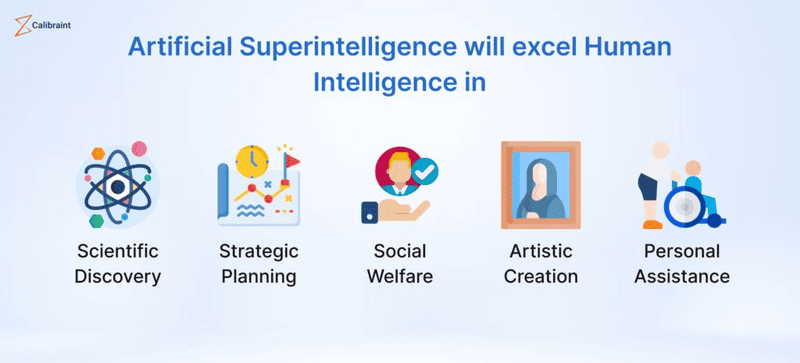
What are the benefits of Artificial Superintelligence?
Researchers and scientists speculate that the benefits could include:
- Enhanced problem-solving: Artificial Superintelligence can analyze and process more data than humans, with greater speed and accuracy. It could solve complex problems in many fields, including politics, scientific research, healthcare, and finance.
- Greater efficiency and productivity: Superintelligence would automate tasks currently performed by humans, minimizing errors and enhancing security.
- 24/7 availability: Unlike humans, ASI systems can operate around the clock, even on holidays.
- Innovation and progress: Experts predict that ASI will be more creative and innovative than humans, creating solutions to problems that humans could not think of. This includes better understanding the physics of the universe, solving the technical challenges of interstellar travel and colonies on different planets, discovering new treatments and cures, discovering new drugs and vaccines, and extending human lifespan.
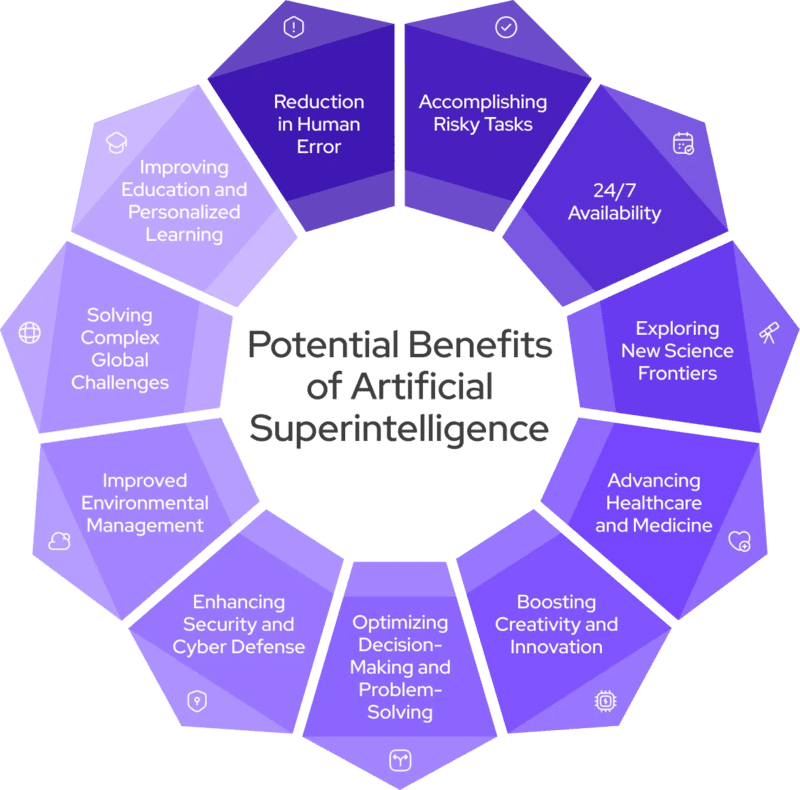
Is Artificial Superintelligence Dangerous?
The risks associated with the development of ASI that scientists warn about include:
- Loss of control: ASI systems may behave and operate in ways that humans cannot understand, predict, or control. ASI’s superior cognitive abilities could pose existential risks to humans, through actions such as taking control of nuclear weapons and destroying humans or all life on Earth.
- Unemployment: Artificial Superintelligence will automate many jobs, leading to unemployment or causing economic and political chaos.
- Weaponization: ASI could dramatically improve the destructive power of military weapons and warfare. Nefarious nations, companies, and organizations could use Artificial Superintelligence to harm humanity, such as collecting large amounts of personal data or perpetuating bias and discrimination through algorithms.
- Ethics and morality: Programming an ASI system with moral and ethical standards can be complicated, as humanity has never collectively agreed on a set of moral or ethical codes. Experts in artificial intelligence have also raised ethical questions about whether an ASI system should have authority over humans to make decisions.
- Environmental impact: Training and continuously running AI models come with high energy demands, increasing carbon emissions into the atmosphere. Manufacturing hardware requires mining metals as well as consuming large amounts of water to cool data centers. All of these impacts could worsen as AI becomes more advanced.
- Privacy: AI models are trained on large amounts of data collected from consumer-generated content or content purchased from third parties. This has led to a broader discussion about AI ethics and data privacy.
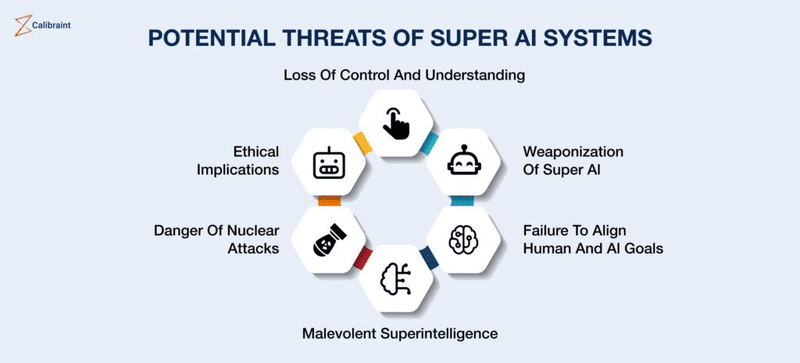
In short, Artificial Super Intelligence (ASI) represents the potential pinnacle of AI development, where machines not only achieve but surpass human intelligence in all areas. While ASI remains a hypothetical concept for now, studying and discussing it helps us prepare for the opportunities and challenges that may arise in the future.
Understanding ASI not only opens up the prospect of unprecedented advances in science and technology but also reminds us of the importance of managing and guiding the development of AI responsibly, ensuring that the potential benefits are realized while minimizing the risks that may arise.
Hopefully, this article has helped you understand what Artificial Superintelligence is. If you need more in-depth advice on FPT GenAI, please contact FPT.AI immediately. This is a platform designed to support businesses:
- Knowledge Management: FPT GenAI can exploit internal knowledge of the business, from reports, processes, lessons learned and best practices. The system allows information retrieval, data comparison, and information synthesis from multiple sources to provide accurate and useful answers.
- Summarizing and analyzing content: FPT GenAI is capable of summarizing long texts, analyzing customer feedback, and identifying strengths and weaknesses to improve customer experience.
- Task support and automation: FPT GenAI combines Q&A capabilities and performing specific tasks. For example: Customers can request to open a card, and the system will automatically switch to task-based processing mode to execute the request quickly and efficiently
Solutions on FPT GenAI not only bring breakthroughs in customer experience and labor productivity, but also create new opportunities in knowledge management, data analysis, and business operation support. Don’t miss the opportunity to take advantage of the power of AI to move towards a better technological world.
